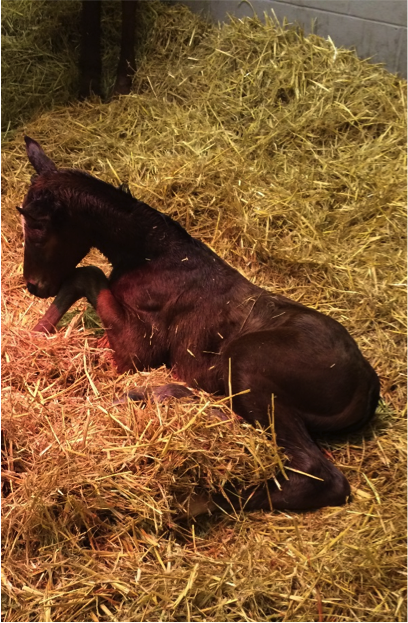Advances in Neonatal Foal Care
Sarah Smith MA VetMB MVetMed DACVIM MRCVS, RCVS Specialist in Equine Medicine (Internal medicine) - 10/12/2017
Advances in Neonatal Foal Care
Neonatal foal care has advanced dramatically over the past 20 years with a better prophylactic care of pre-partum mares and neonatal foals, greater ability to identify high-risk foals early on, more advanced treatment options and markedly improved survival rates. This article will outline how to identify high-risk foals and what has changed recently in the way neonatal foals are managed.
Improved survival rates
The odds of survival for foals admitted in the 2000s are 3.4 times higher than they were for foals in the 1980s, taking the percentage of hospitalised foals surviving up to 81%. A study in Ireland also showed that being hospitalised as a foal does not adversely affect the future sales performance of Thoroughbreds suggesting that even by 1 year old the foals are matching their cohort, at least in size.

Why are neonatal foals at risk?
Parturition represents a time of high risk to neonatal foals with approximately 10% of equine parturitions resulting in dystocia, although the risk is higher in Thoroughbreds than other breeds. It is well established that the timings of parturition impact on survival and we now know that when stage 2 labour lasts more than 40 minutes there is increased foal mortality. This understanding of the importance of timing has led to adjustment in the management of dystocias; for example, in areas with large stud farms with very experienced staff, the mare may be travelled direct to the hospital if the stud cannot deliver the foal themselves, as this saves on travel time of the vet.
The development of sepsis is associated with non-survival and several recent studies have attempted to advance our abilities to assess the severity of sepsis and predict the survival of foals. Many factors including positive blood culture, orthopaedic disease, neutropenia, hypothermia, acid-basis status and sepsis score are all risk factors for non-survival. Metabolic and endocrine profiling are also being developed to help to predict survival. The outcome of foals with septic arthritis has been better in recent papers than previous reports with 80% of these foals with septic arthritis surviving to discharge and 62% with long-term athletic soundness, which is significantly better than previous figures for septic arthritis in foals. However there may be variation between breeds to future career requirements and it is still difficult to predict early-on which of foals will have a successful outcome.
What can be done to continue advancing neonatal care?
Foals are at uniquely high risk of sepsis due to immunological naivety at birth, the reliance on passive transfer of immunity and the opportunistic infection through the open gut, umbilicus and respiratory tract by ubiquitous organisms. Recent developments have shown that when foals were sampled regularly for 72 hours after birth, 4 out 7 apparently healthy foals had transient bacteraemia within the first 24 hours of life. This, and several other studies, have highlighted the importance of colostral antibody transfer and the benefit of measuring neonatal immunoglobulin concentration, currently IgG concentration. Foals with an IgG concentration <4g/l were 8 times less likely to survive in one recent study. However it is likely that the importance of colostral antibody supply is dependent on other factors such as the foal’s environment and overall level of care provided. There is on-going work looking at the importance of the transfer of maternal IgA and whether maternal IgA concentrations can be optimised pre-partum to benefit the foal post-partum.
A large scale study performed in Newmarket provided a huge amount of information about the risk of infection in foals less than 30 days old. The study showed that complications at birth and a high white blood cell count after birth were associated with an increased risk of infection. Interestingly, foals that were stomach-tubed with colostrum were also at increased risk of infection, suggesting that the process may introduce infection which aiming to protect against it. This same study provided evidence that has significantly changed clinical practice; there was no difference in the incidence of infectious disease when foals were given three days of antimicrobial treatment. In recent years there has been a move away from routine use of antimicrobials in healthy, low-risk neonatal foals. Instead emphasis is placed on the hygiene standards of the stud farm and vets, in particular the importance of veterinary hygiene such as wearing gloves and providing individual, sterilised equipment for each foal.
Prophylaxis and prevention
The use of probiotics has become increasingly fashionable in many areas of veterinary practice in recent years. There is an assumption that they could not do any harm and that they might be of benefit to the gastrointestinal tract, as up to 60% foals develop diarrhoea in the first 6 months of life. However there are currently conflicting opinions on the routine use of probiotics in foals as studies have shown both benefits (a decrease in the incidence of diarrhoea from 76 to 31% and increased weight gain in one population of foals) and adverse effect (foals receiving probiotics were more likely to develop diarrhoea requiring veterinary interventions).
There is a high prevalence gastric ulceration in foals and the impact can be severe with the potential for perforation or outflow obstruction to develop. As a consequence, a trend developed for the use of prophylactic anti-ulcer medication, however this has recently reversed. Recent evidence shows that ulceration frequency does not alter with the use of anti-ulcer medication in foals, and that anti-ulcer medication in the NICU is associated with a 2-times increased risk of developing diarrhoea. This is likely because the acid-suppression reduces the gastric barrier function allowing colonisation of the gastrointestinal tract by pathogens. However this has reduced the use of acid-suppression medication in exchange for mucosal protectants such as sucralfate in foals less than 2 weeks old. Acid-suppression medication is still commonly used in older foals.
Dummy foals
Big developments have been made in the understanding of neonatal maladjustment syndrome, so called “dummy foals”. A group at UC Davis, California, have shown that in utero the foetus has high levels of circulating neuroinhibitors, particularly progestogens, which keep the foal in a sleep-like state. In the normal foal these neuroinhibitors decrease during parturition and the first 24 hours of life, however they are maintained or even increased after parturition in dummy foals. This discovery offers exciting avenues for treatment of these foals in the future. However one seemingly very simple technique is already offering hope; “the squeeze technique”. Squeeze-induced somnolence can be used both as a method of restraint in neonates and also as part of the treatment for dummy foals with resolution of the signs of foetal consciousness occurring after treatment.
Neonatal care is advancing
Research in recent years has led to a significant improvement in the preventative and therapeutic care of neonatal foals, and there are many new exciting developments. The improvement in the quality of care has been reflected in dramatic improvements in the survival rates of neonatal foals which should continue in years to come.
This article is kindly provided by Langford vets and was written by Sarah Smith MA VetMB MVetMed DACVIM MRCVS, RCVS Specialist in Equine Medicine (Internal medicine), Equine Medicine Clinician, Langford Equine Centre, University of Bristol.
CLICK HERE for details of CPD courses by Langford Vets including FREE pub evenings!





